What Is Clabbered Milk, Anyway?

For as long as humanity has been drinking milk, we've been trying to find ways to extend its shelf life. Kept cold, milk can last about a week, no more. But once it's been fermented, as with buttermilk or sour cream, it sees its shelf life extended to three weeks or longer. Especially in a time before refrigeration, it's clear why our ancestors had good reason to find ways to safely and deliciously culture any leftover dairy.
Around the world, different preservations are used to extend the shelf life of dairy. In France, while much of the fresh milk supply is treated with ultra-high pasteurization (UHT) to make it shelf-stable, which keeps its flavor relatively similar to that of fresh, dairy farmers have also created more than 1,000 different kinds of cheese. In Central Asia and the Balkans, the tradition of making kefir has been passed down through the generations, and in the Indian subcontinent, it's a yogurt-like thick curd that's center-stage.
Ireland's answer to this conundrum is a product called clabbered milk, clabber milk, or bainne clábair in Irish. Made using wild fermentation of raw milk, it's perhaps less popular in the days of widespread pasteurization, but it's certainly worth a closer look.
Read more: 12 Little-Known Facts About Salt
What Is Clabbered Milk?
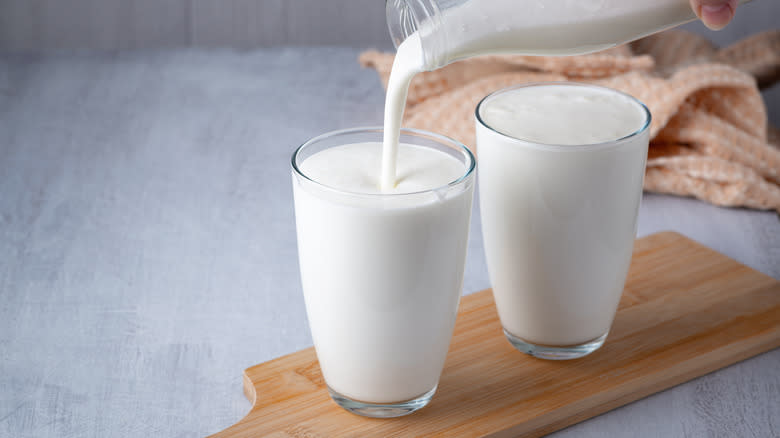
The Irish name for clabbered milk, bainne clábair, gives some indication of how it came to be. Directly translated as thickened milk, clabbered milk is milk that is slightly thickened due to a process of natural souring or culturing. This process occurs naturally when the raw milk is exposed to the air and certain airborne bacteria, and the resulting milk can be kept longer than fresh.
Clabbered milk has long been a popular choice in Ireland, where the English Earl of Stafford first remarked it in 1635. At the time, he described it as "the bravest, freshest milk you ever tasted" — and indeed, it has a tangier, more robust flavor than fresh milk. Dubbed bonnyclabber in English, clabbered milk was brought to the United States by Scots-Irish immigrants. It quickly became popular in regions like Appalachia, where it was often used to make cottage cheese, and in the Southern U.S., where it's often enjoyed chilled and drunk over ice.
How Does Clabbered Milk Work To Leaven Baked Goods?
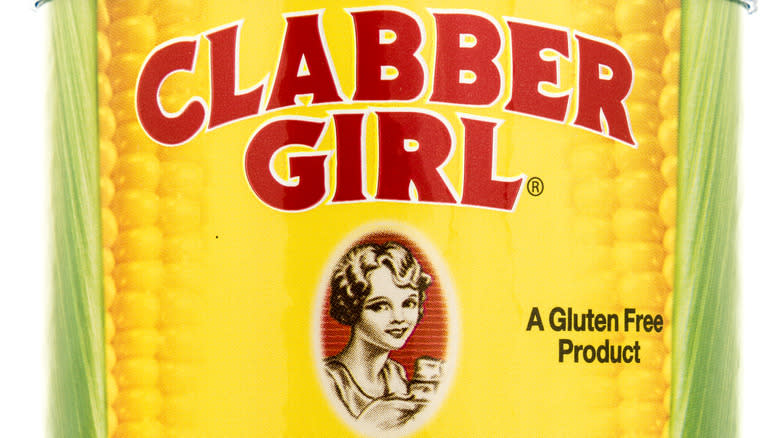
If you've heard of the Clabber Girl brand of baking powder, you'll get a hint at one of the most popular uses for clabbered milk. Indeed, before baking powder was even invented, clabber was being used to help baked goods rise (not to mention to give them a lovely tang). The way this works is a matter of simple chemistry. The clabber would be used in tandem with baking soda, aka sodium bicarbonate, in batters for quick-rising breads and cakes. The acidic clabber would react with the alkaline baking soda much as vinegar does in that time-tested volcano science experiment, only instead of causing an explosion, it would form air bubbles in the batter, leading it to rise.
We have brothers Francis and Herman Hulman to thank for baking powder, which they developed in the 1850s. Their original recipe combined sour milk and ash to create a product with both acid and base that was activated when added to batters. Clabber Girl was born.
How To Make Clabbered Milk
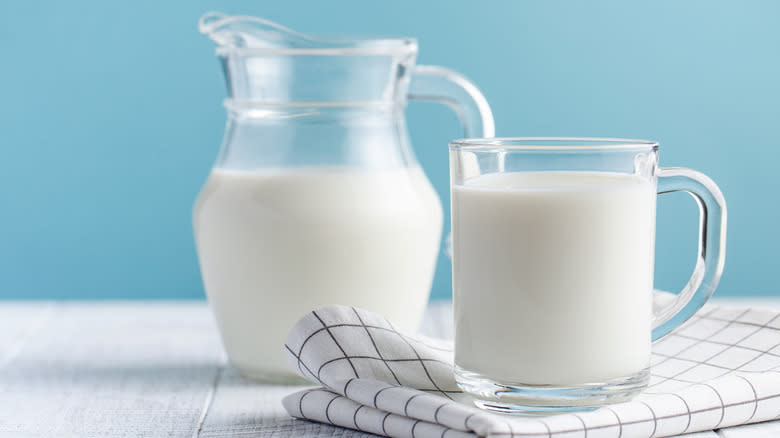
Clabbering milk isn't difficult to do. Seeing as it's a natural process, all you need to do is encourage Lactobacillus bacteria to multiply in raw cow's milk. (Yes, clabbered milk is indeed teeming with little microbes; but no, it's anything but spoiled milk!) To make clabbered milk, specific, sought-after bacteria are encouraged to produce lactic acids, which they do naturally as they consume the lactose present in the milk. The production of these acids sours the milk, preventing dangerous pathogens from growing in the newly acidic environment.
If you want to try your hand at making clabbered milk at home, start with raw milk, which should be placed in a sterilized jar and left to sit, covered, at room temperature for anywhere from 1 to 5 days. The milk will soon begin to coagulate and form a jelly-like texture. It is then ready to consume or to feed more raw milk, much like a sourdough starter, in a ratio of 50 parts raw milk to 1 part clabber.
How Can You Tell If Your Clabbered Milk Has Gone Bad?

Just because clabbered milk is naturally fermented doesn't mean it can't go off. Your clabbered milk can accidentally become infected with other bacteria, and it can also just be too old to still be delicious. Luckily, there are some easy-to-read signs that your clabbered milk is not at its peak.
Signs that clabbered milk is healthy are a slightly acidic, sweet aroma and flavor. It should smell and taste not dissimilar to yogurt. On the other hand, indications that clabbered milk has gone off include the formation of bubbles within the clabber or an unpleasant, rotten smell. Clabbered milk that has separated into two different textures is also likely off and may be unpleasant or even unsafe to consume. If ever you're in doubt, it's best to dump your clabber and start over; luckily, since a new fermentation begins in as few as two days, you won't have long to wait until your clabber stores have returned.
Can Clabbered Milk Be Made With Pasteurized Milk?
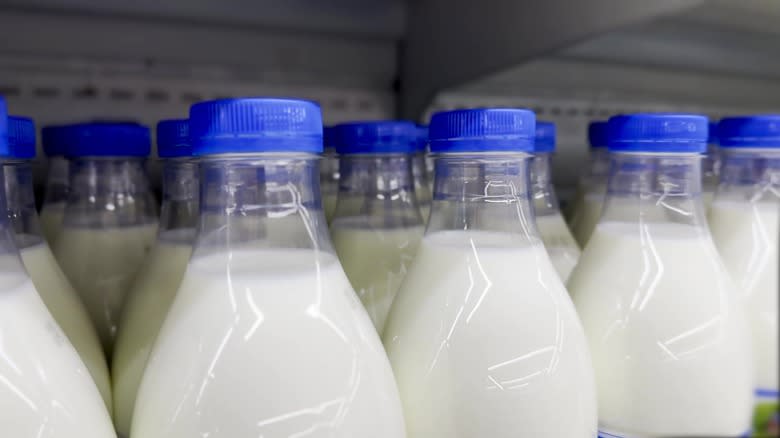
Clabbered milk is typically made with raw milk, and experts remain divided on whether pasteurized milk is a good substitute. Most assert that because of the dearth of healthy bacteria in pasteurized milk, pasteurized clabber is difficult or nearly impossible to make at home, and pasteurized milk one attempts to clabber will likely spoil before souring. Indeed, it is perhaps in large part due to our widespread reliance on pasteurized milk that clabbered milk is becoming harder to find.
Some say it is possible to make clabber with pasteurized milk by adding the right live cultures to it, much as one would make yogurt, but not only is this far more work than traditional clabber, but this pasteurized iteration of clabbered milk is unlikely to have the same beneficial bacteria in it that make true clabbered milk so good for you ... and so delicious.
Can Clabbered Milk Be Made With Sheep's Or Goat's Milk?

Clabbered milk is typically made with cow's milk, but it can certainly be made with other milks. The process of goat's milk is quite similar to clabbering cow's milk, and the resulting product boasts many of goat's milk's innate health benefits. Goat's milk is naturally richer in protein, and what's more, this protein is more easily digestible than that of cow's or sheep's milk.
Sheep's milk is another easy milk to clabber, and it's also better for you than cow's milk. Research published by the University of Auckland-based Liggins Institute in 2019 showed that sheep's milk is easier to digest than cow's milk and is denser in certain nutrients, especially healthy fats like branched-chain amino acids and conjugated linoleic acid. CLA has notably been shown to potentially improve immune function and even promote weight loss through the natural reduction of body fat.
How Is Clabbered Milk Used Around The World?
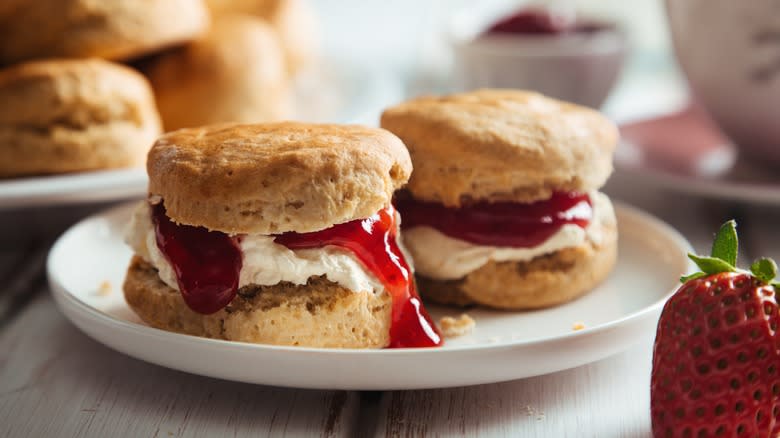
Clabber originally comes from Ireland, where it is often left to thicken long enough to become clotted cream — a heavenly topping for scones. When immigrants brought clotted cream to America, it was soon embraced, particularly in the American South, where it is often enjoyed over ice, or in Appalachia, where it's seasoned simply with salt and pepper.
But clabber — or other forms of soured milk — is popular around the world. In Ukraine, a similar product is used to enrich pancake batter or borscht. Dahi is an Indian variation that requires heating and results in a thicker curd; it often enriches both savory curries and sweet curd pudding known as dahi ka halwa. Nunu is beloved in West African countries including Ghana, Nigeria, and Burkina Faso, and may be the most similar to clabbered milk, seeing as it's spontaneously fermented and made with cow's milk. It's often used in the region to make spiced millet balls that are popular for lunch.
What Are The Differences Between Clabbered Milk And Buttermilk?
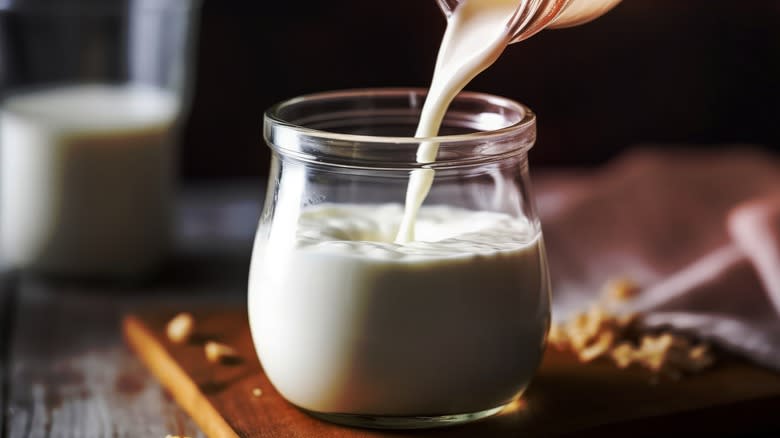
Clabber is not the only fermented milk product out there, and it stands out from other similar products in a few key ways. Perhaps the most similar in texture and flavor is buttermilk, something that's evident in the fact that buttermilk is so often proposed as a stand-in for true clabber. But buttermilk, while also a sour fermented milk product, is not made in the same way as clabber.
Traditionally, buttermilk is the word for the thin milk leftover after cream has been churned to make butter — which of course is how it got its name. These days, however, most commercially available buttermilk is made by adding an acidifying bacteria to milk, which means that it's far easier to make pasteurized buttermilk than it is to make pasteurized clabber. Differences aside, buttermilk shares clabbered milk's sourness, making it a great leavening agent for certain baked goods that capitalize on that still-same acidity.
What Are The Differences Between Clabbered Milk And Yogurt?
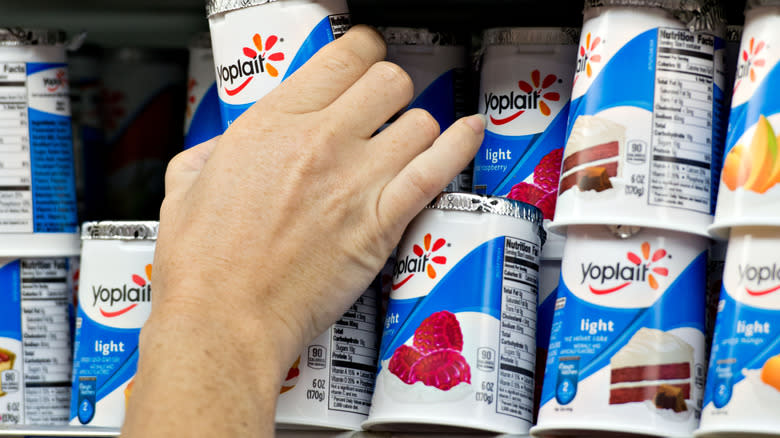
Yogurt is yet another popular fermented milk product, but despite having similar acidity to clabbered milk, it stands out in that it's made by introducing a specific bacterial culture to the milk — usually Lactobacillus bulgaricus and Streptococcus thermophilus. The reliance on the same culture each time results in a more consistent product, as opposed to the variety wild fermentation invites in clabbered milk.
Perhaps the biggest difference between clabbered milk and yogurt, however, is the fact that yogurt is so widely available. You'll find a wide variety of yogurt brands at any supermarket, some of which are far healthier than others. While at its best, yogurt is as good for you as any other fermented milk product, the fact that so many rely on added sugars means that many store-bought yogurts are a little better than junk food. Choose yogurt made with live bacteria and with little or no added sugars, pairing them instead with fresh fruit for a touch of sweetness.
What Are The Differences Between Clabbered Milk And Kefir?
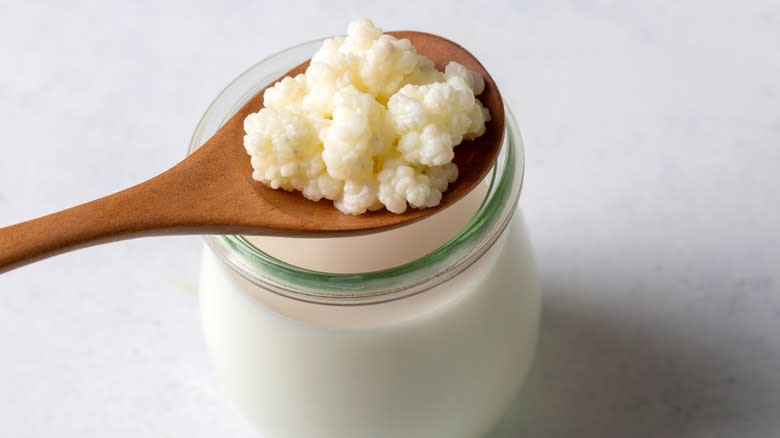
Kefir is yet another cultured dairy product, but it's quite distinct from either clabber or yogurt. It originally hails from Central Asia, where it has been made for millennia by nomadic peoples, who took advantage of its longer shelf life to ensure they had sufficient food through the long, harsh winters. Kefir was notably instrumental in creating some of the world's first cheeses.
Kefir stands out from clabbered milk in a number of ways, the first of which is how it's made. Much like yogurt, kefir relies on cultures that must be added to the milk you're looking to transform. These kefir cultures have been passed down through generations of residents of this region, and some say that every kefir grain is a descendant of that first kefir creation. Another way that it stands out from clabber is in its shape; when added to milk, kefir takes on a granular form that some compare to cauliflower. It's this "grain" — and not an actual seed — that gives kefir its name.
What Does Clabbered Milk Taste Like?

Clabbered milk has a similar flavor to other kinds of fermented dairy: Boasting a lovely richness and a slight acidity, it is above all characterized by having a pleasantly sour flavor. Texture-wise, clabbered milk on its own is slightly thicker than regular milk, but it can be fermented longer into thicker, richer, spreadable clotted cream or tangier cottage cheese with its signature lumps.
If you've never tasted clabbered milk, the fact that buttermilk is often offered as an alternative should give you a clue into its flavor: that of a balanced acidity. While it's an acquired taste enjoyed on its own, its lactic tang is welcome in baked goods or marinades like Nigella Lawson's buttermilk chicken recipe or classic buttermilk biscuits. Its acidity can also be offset with a bit of sweetness; many pair it with cinnamon and sugar, in porridge, or all on its own.
How To Use Clabbered Milk
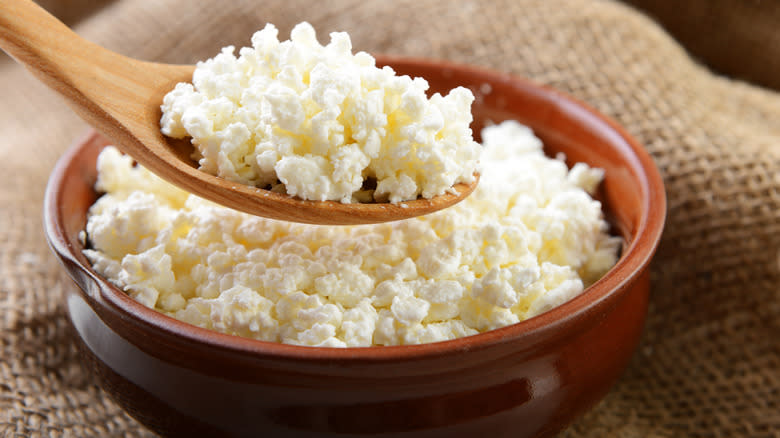
There are so many fun ways to enjoy clabbered milk. Traditionally used as a leavening agent in baking, clabber can still be used in place of buttermilk in a 1-to-1 ratio. Consider using it to make buttermilk biscuits or buttermilk cornbread to reap the benefits of its leavening power and lactic flavor. And buttermilk isn't the only ingredient clabbered milk can stand in for. It's also a great swap for yogurt in smoothies, dips, or salad dressings. You can also spread clabber on toast or biscuits in place of butter or clotted cream. It's lovely on its own, seasoned with salt and pepper, or sweetened with a touch of jam or honey.
Clabber can also be used as a starter culture for homemade cheese, replacing freeze-dried cultures in the recipe of your choosing. Cottage cheese is perhaps the simplest way to start. All you need to do is heat clabbered milk at 115 F, then strain it for about an hour. The cottage cheese can then be enriched with heavy cream and seasoned with salt.
Nutritional Information About Clabbered Milk

Clabbered milk is a naturally fermented raw cow's milk product, and as such, it's jam-packed with healthy bacteria to promote good gut health. In fact, according to Harold McGee's "On Food and Cooking, the Science and Lore of the Kitchen," fermented milks like clabbered milk are even better for you than supermarket yogurt and buttermilk thanks to the preponderance of the bacteria that spontaneously ferment in these products — bacteria like Lactobacillus fermentum, Lactobacillus casei, and Lactobacillus brevis. These microbes are part of the greater category of probiotics, which help promote good gut health.
One 2022 study in Frontiers in Immunology indicates that these bacteria may help prevent intestinal damage and reduce intestinal inflammation. And that's not all. Most medical experts today believe that promoting good gut health isn't just good for your digestion; it's also good for your brain. This is due to the brain-gut connection, which contributes, for example, to the increased likelihood of anxiety and depression among those with IBS. On the flip side, taking good care of your gut also means you're taking good care of your mind, mood, and general well-being.
How To Store Clabbered Milk
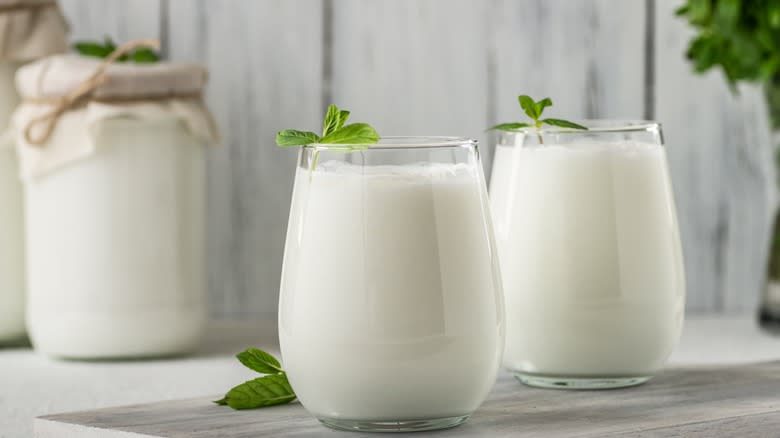
Clabbered milk is typically made right on the countertop at room temperature, so storing it is fairly simple. All you'll want to do is be sure to cover it to keep it safe from contaminants: a coffee filter or muslin cloth with an elastic band works nicely. Don't use too tight a cover, as you want the milk to be able to breathe as it ferments.
Once your clabber has fermented long enough, however, you'll want to stop the fermentation process, and that's something the modern marvel of refrigeration can help with. Simply transfer your clabber to the fridge, which will prevent the fermentation from continuing. You'll typically want to consume it within a week, but if you have any leftover, you can always use it as a starter culture to continue producing even more clabbered milk at home.
If you're going to be traveling or if you fear you won't be able to use your clabber before it goes off, it can be frozen. Distribute well-fed, healthy clabber in ice cube trays, and freeze until solid. Then simply store the frozen cubes in a plastic bag for up to three months, defrosting as needed.
Read the original article on Mashed.